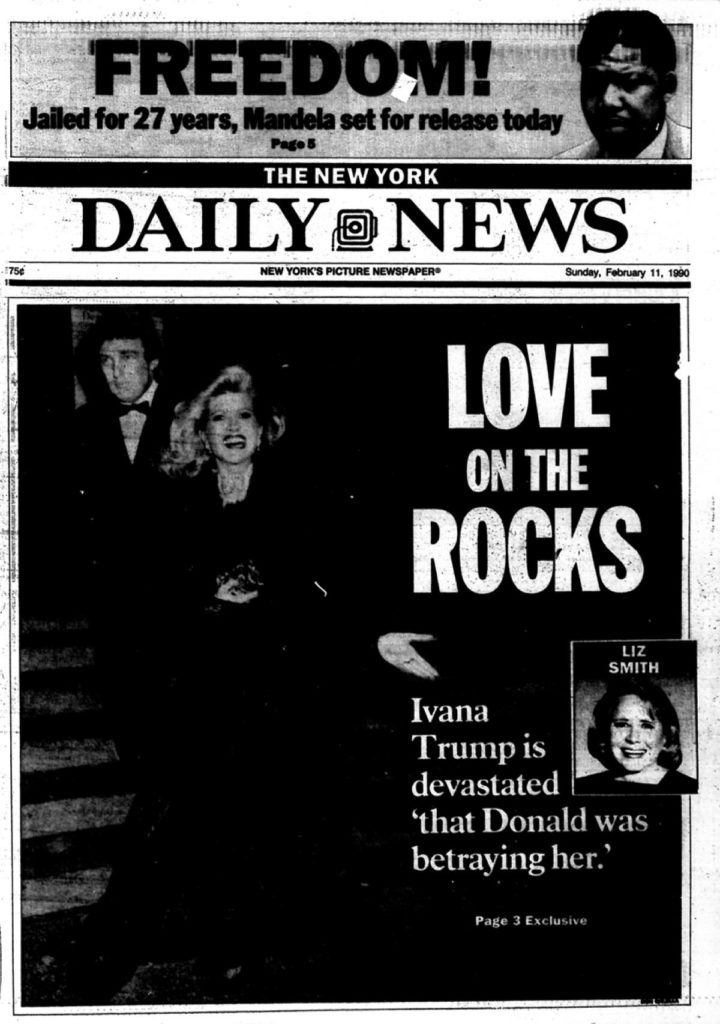No Rumor: Liz Smith Dies at 94
By • November 16, 2017 0 934

“GOODE FRIENDS, for friendship’s sake forbeare to utter what is gossipt here. In social chat lest unaware thy tongue offend thy fellow players.”
That’s an inscription above the main fireplace at the Players Club off Gramercy Park, according to a February 2009 column by legendary columnist Liz Smith, who traded in “gossipt” like a woman who was part chocolatier and part gunslinger — and part best friend, the latter a quality not usually associated with members of the tribe. More often than not, Smith tended to buddy up to her subjects and celebrate them.
Smith, who died Nov. 12 at the age of 94, was known for many things and by many names, notably the “Grande Dame of Dish.” The title “New Yorker” would have pleased her too, especially since she was a Fort Worth, Texan, to begin with, a fact verified by a slight drawl.
A regular and a favorite at the Players, which goes back to Edwin Booth (brother of you-know-who) and Mark Twain, she got a kick out of the fireplace inscription. Reading that column — and reading about Smith — is to sense a flavor in the air, passing by your window and disappearing in a flourish. Of course, professional gossips still exist, but something is lacking in the stew that passes itself off as gossip today.
Smith was raised in a time when the big deals and the big dreams were offered by movie stars: the Astaires, Garlands, Turners and Gables. She apparently had some thoughts to also go Westward Ho, as in Hollywood. Instead, with 50 bucks in her purse and high spirits, she headed in the opposite direction, to the town with the biggest, brightest lights — Manhattan.
She landed a job at Modern Screen, one of those movie mags impossible to miss on a newsstand in the 1950s. But she also took her first steps toward a kind of legendhood, a path already taken in Hollywood by the likes of queen bees Louella Parsons and Hedda Hopper, she with the hats but less heart.
Before Smith took her first step toward queen bee of New York, landing a job as a columnist at the Daily News (she later wrote for the New York Post), she did everything, made her bones, did the work. She proofread, typed, reported and wrote, then became a news producer for Mike Wallace in his radio days.
She was a television news producer, worked on “Candid Camera,” was a ghost writer for Hearst’s “Cholly Knickerbocker” gossip column and worked for Cosmopolitan (and another legend, Helen Gurley Brown), as well as, get this, Sports Illustrated as an entertainment editor.
During a newspaper strike in New York, she also appeared on television, becoming a familiar and popular face and personality. Adopting a cool but comfortable, stylish but not splashy look, Mary Elizabeth Smith was transformed into Liz Smith.
She understood something basic. She did not consider herself a zinger, an exposer of secrets. She needed access and she got it; people liked not just being written about by her but being with her.
And how could we omit her Trump connection? She may have been responsible for the Donald setting out on the road to where he is now, day and night, by making him a prince of the city. She had already cultivated Donald and Ivana — dined with them, socialized with them and so on — when Ivana decided to give Smith the biggest scoop of her life: that the Trump household was in trouble and a big split was coming.
She was one of the highest paid people in New York, dining out, always at the big parties, hobnobbing, reporting. Married twice, she also had her own secret: she happened to love women. When she “came out” — not as gay but as bisexual — it was in a very matter-of-fact way, calling her status “gender neutrality.” She was quoted as saying, “I just never felt I was wife material. I always felt that I was a great girlfriend.”
Her columns had a dot-dot-dot or bullet style. They were a mix of opinions, sightings, praise, who ate were, who was getting together or splitting up — humor, rumor and gossip, mixed with facts and a kind of genteel but hard-driving energy.
That February 2009 column was characteristic not only of her style, but of the gossip style at large, out in the world, going from here to there, telling stories, including one about a reading by Elaine Stritch with Gina Gershon, attended by Barbara Walters, Michael Feinstein, Tommy Tune, Nathan Lane, Dixie Carter and Hal Holbrook and others.
This was a New York evening, with stars galore. She talked about Marni Nixon, the voice to the stars, followed by a reference to the Oak Room as “hot” and the possibility of a lunch with Kate Winslet, hosted by Elie Wiesel and Gloria Steinem. Riding in a cab, she sees a tease for a new television show “My Name is Earl.”
It’s all a little breathless, a little jam-packed and overpopulated like New York itself, like a long life lived awfully well, before reality-show celebrities crowded into the “gossipt” pages, followed by the flash of paparazzi cameras aiming for the Kardashians.
And Smith was quite the phrase turner. “Gossip,” she said in an interview with People magazine’s Jess Cagle, “is news running ahead of itself in a red satin dress.”
Sweet.

